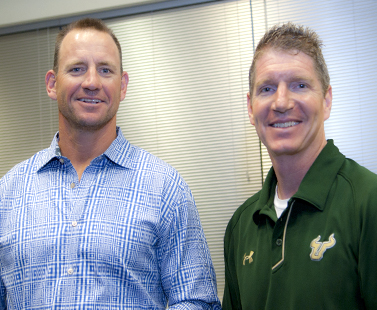Experts discuss ways to protect young athletes from concussions
Coaches, parents and even kids are more aware about the seriousness of concussions, but more needs to be done to ensure that young athletes who experience these head injuries are properly identified and do not return to play prematurely.
That was the consensus of a panel of experts, including two USF Health doctors, who participated in the Central Florida Concussion Summit presented by the USF Health Department of Orthopaedics and Sports Medicine and HealthyState.org. The March 28 event at the USF College of Education TECO Conference Hall drew parents, coaches, healthcare professionals, athletic trainers and other members of the sports community.
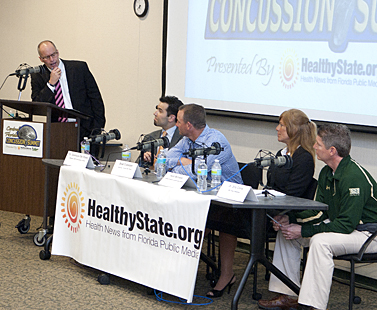
L to R: Fox 13’s Russell Rhodes moderates the discussion by panelists Dr. Gianluca Del Rossi, director of the USF Health Concussion Center; attorney Brad Culpepper, former NFL football player; Heidi Michaels, a high school athletic trainer and coach; and USF Health’s Dr. Eric Coris, head medical team physician for USF Athletics.
A concussion is an injury to the brain caused by a blow to the head. It usually happens when the head accelerates and stops suddenly, prompting the brain to bounce back and forth against the skull’s hard surface. Most concussions do not result in loss of consciousness, and even mild ones need to be recognized and managed to avoid potentially devastating complications.
“It’s important for those who guide young athletes to have a good command of all the symptoms of concussions,” said Dr. Eric Coris, the head medical team physician for USF Athletics and a USF Health physician specializing in primary care sports medicine. That includes subtle signs like sleep disturbances and emotional changes as well as the more obvious symptoms like headache, dizziness, balance problems, or confusion, he said.
“The other thing is never letting someone play who is still experiencing symptoms,” Coris said. “If you do those two things, you can protect a lot of kids.”
Coris was a member of the Central Florida Concussion Summit panel along with Dr. Gianluca Del Rossi, director of the USF Health Concussion Center; Brad Culpepper, local attorney and former NFL football player; and Heidi Michaels, an athletic director and coach at Anclote High School in Pasco County. Russell Rhodes, co-anchor of Fox-13’s Good Day Tampa Bay, moderated.
Jeff Konin, PhD, executive director of the USF Sports Medicine and Athletic Related Trauma Institute, was a panelist at a second community outreach seminar — the South Florida Concussion Summit held March 30 at Memorial Regional Hospital Auditorium in Hollywood, FL.
A bill making its way through Tallahassee would standardize head injury management for high school and youth league athletes across all Florida counties. The proposed legislation would also require a physician to clear a student athlete to return to play.
“Right now there’s nothing we have to do as high school coaches in terms of concussion education,” Michaels said. Videos and courses materials are available but there is no formal protocol and training is voluntary, not required, she added.
The level of concussion education is even less for those overseeing youngsters in youth sports leagues, said Culpepper. “Too many Pee Wee football coaches don’t know what they’re doing.”
Brad Culpepper and Dr. Eric Coris
Supported by a state appropriation, full-time certified athletic trainers from the USF Sports Medicine and Athletic Related Trauma Institute are placed in Hillsborough County high schools that previously had no formal health care available for athletes. Offering guidance to student athletes in the prevention and treatment of sports-related injuries, they are proactive about watching out for concussion symptoms and keeping kids out of the game when it is in the athletes’ best interest.
But many counties, coping with increasingly tight budgets, have no certified athletic trainers in schools, relying instead on administrators or volunteers to monitor students on the playing field.
Over the last several years, studies have provided researchers and physicians with more information about the effects of concussions. Among the findings discussed by the panelists:
• High school athletes who suffer three or more concussions are nine times more likely than those with no history of concussions to experience longstanding neurocognitive impairment, which can lead to problems with academic performance and social interactions. “The cumulative effects of concussion are very real and persist a long time,” Coris said.
• In sports played by both men and women, women suffer more concussions. Studies show female athletes also experience more symptoms and take longer to recover than males. Women and girls may have less neck strength than males, affecting their ability to withstand a blow to the head. Perhaps they have a different style of play that makes them more vulnerable, or maybe they are just more honest about reporting symptoms. “There are some theories, but we don’t know why,” Dr. Del Rossi said.
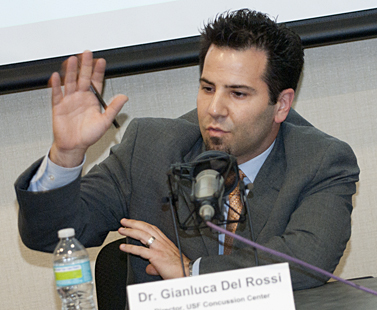
• Because their young brains are still developing, children and teens appear to be more vulnerable to a potentially deadly condition known as second-impact syndrome. Another blow to the head before complete recovery from the initial concussion may result in massive brain swelling. “You have to be especially conservative about letting them return to play,” Dr. Coris said.
• While research is inclusive, some studies suggest certain people may be genetically predisposed to sustaining concussions and at greater risk of developing chronic traumatic encephalopathy, which mimics degenerative changes in the brain seen in dementia. Lab findings on the brains of deceased professional athletes who suffered repetitive concussions show a buildup of the harmful protein tau, a hallmark of Alzheimer’s disease.
In response to audience questions about ways to help reduce concussions, USF Health’s Del Rossi said rule changes designed to minimize the types of collisions that lead to head injuries and enforcing existing rules would go a long way.
In addition, several tests, some quite inexpensive, now allow physicians or certified athletic trainers to gather “baseline” information about an athlete’s neurocognitive performance in pre-season. If that same student suffers a concussion during the season, Del Rossi said, a post-injury test can help officials more objectively monitor the student’s recovery and better determine when it’s safe for the player to return to the game.
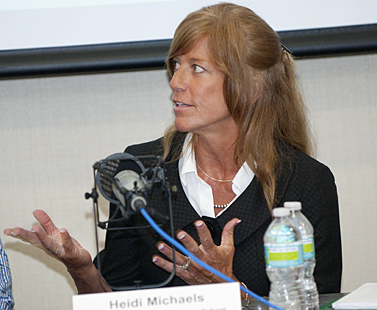
Despite being more informed about concussions, concern remains that student athletes and their parents may not fully appreciate the potential long-term consequences of even “dings,” or minor bumps, to the head.
“You can’t leave staying out of the game up to the players,” Culpepper said. “As a football player, I can tell you the mentality is ‘I’m fine. I’m going back in.’”
“When in doubt (about concussion), we sit them out,” athletic trainer Michaels said. “But it’s tough to pull the parent aside and say your kid is not going to play.”
Unlike broken bones, evident from casts and splints, concussions tend to be invisible injuries. It’s become easier to manage concussions from the sidelines in the last few years because coaches are more knowledgeable about the nuances, Coris said.
“But,” he added, “when you tell a parent Johnny may have a life-threatening condition and really shouldn’t play yet, they still sometimes say, ‘OK, but can you sign this clearance form?’”
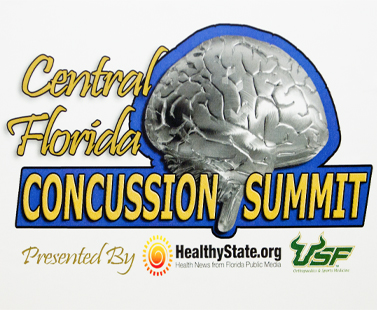
For more information on the USF Concussion Center, visit www.USFConcussionCenter.com
For more information about the Concussion Summit, visit http://healthystate.org/concussionsummit
– Story by Anne DeLotto Baier, and photos by Eric Younghans, USF Health Communications

